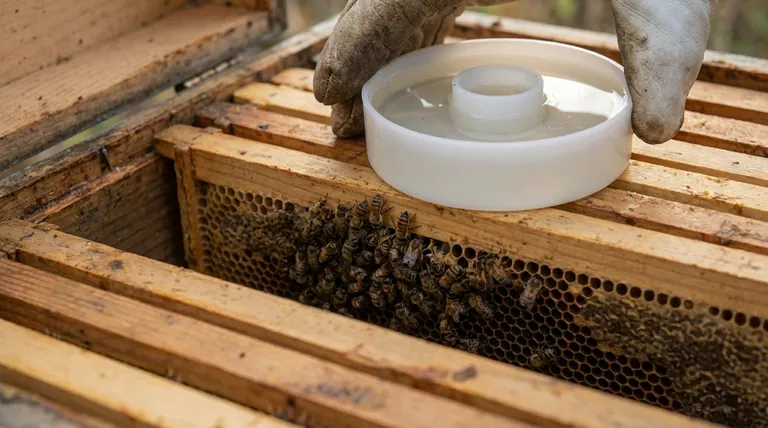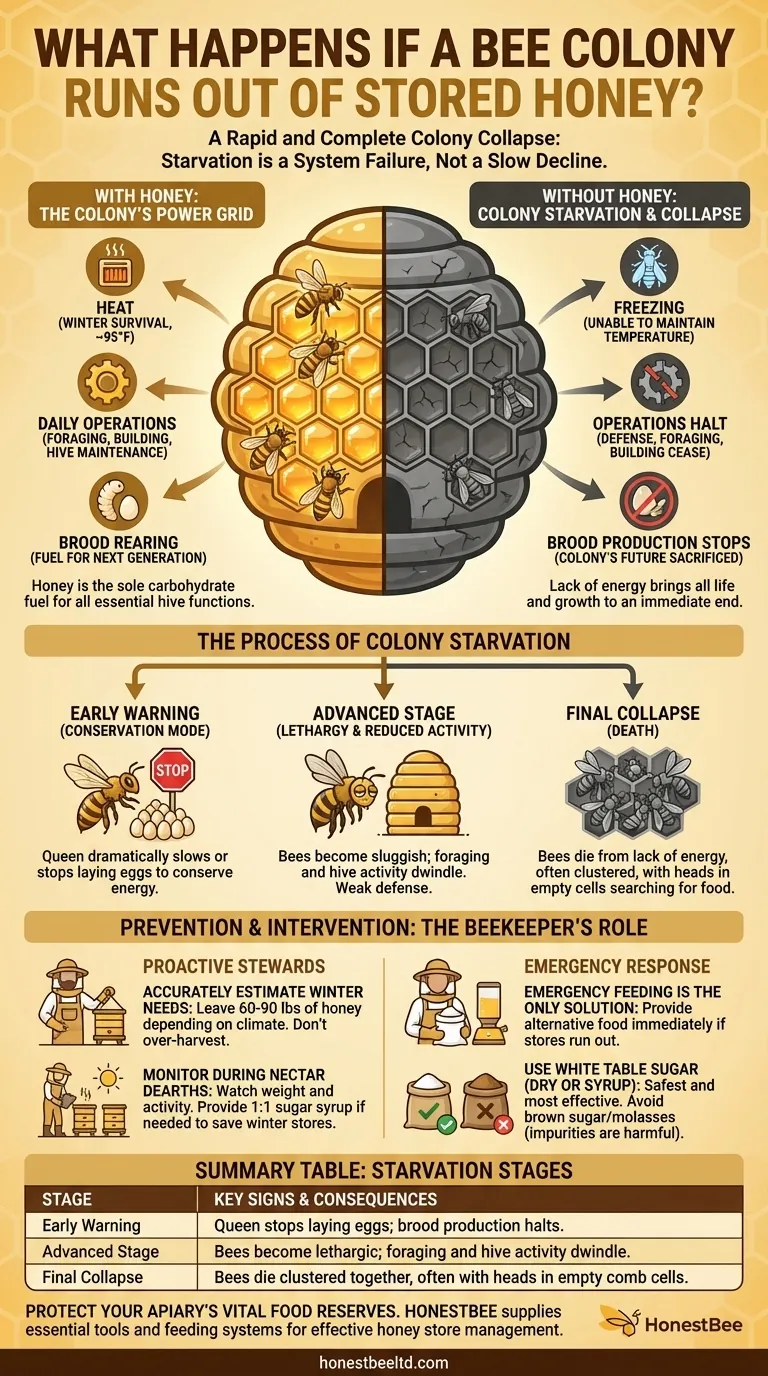When a honey bee colony runs out of honey, it starves. This isn't a slow decline; it is a rapid and complete collapse of the entire colony. Honey is the sole food source that provides the energy necessary for bees to survive periods when they cannot forage, such as winter or extended periods of bad weather.
A colony without honey is like a city without a power grid. All essential functions—heating, defense, and life itself—cease, leading to a swift and total loss. The beekeeper's primary responsibility is to ensure this energy reserve never fully depletes.

Why Honey is Essential for Survival
Honey is the carbohydrate that fuels nearly every activity within the hive. It is the colony's pantry, stored for times when fresh nectar is unavailable.
The Engine of the Hive
Bees convert the energy from honey into heat, allowing them to maintain the critical internal temperature of the cluster (around 95°F or 35°C) needed to survive cold winters. Without this fuel, they literally freeze.
Powering Daily Operations
Every flight a forager takes, every cell a worker bee builds, and every larva the nurse bees tend to is powered by honey. A lack of this energy source brings all hive maintenance and growth to an immediate halt.
Fuel for the Next Generation
Raising brood (bee eggs, larvae, and pupae) is an energy-intensive process. The queen will cease laying eggs if energy stores are low, sacrificing the colony's future to conserve resources for the existing adult bees.
The Process of Colony Starvation
Starvation is not just a lack of food; it's a cascade of system failures within the hive. Recognizing the signs is key to intervention.
First Sign: Brood Production Stops
To conserve energy, the queen dramatically slows or completely stops laying eggs. A beekeeper inspecting a frame will find no eggs or young larvae, a clear signal that the colony is in conservation mode.
Second Sign: Lethargy and Reduced Activity
Bees will become noticeably sluggish. Foraging activity at the hive entrance will dwindle or cease entirely. Inside the hive, the bees will be slow-moving and may not mount a strong defensive response.
The Final Stage: Colony Collapse
In the final, tragic stage, the bees die from a lack of energy. Beekeepers often find the dead bees clustered together, many with their heads facing into the empty honeycomb cells, a classic sign they were searching for the last drops of food.
Understanding Prevention and Intervention
The most common cause of colony starvation in managed hives is human error, typically over-harvesting honey. A beekeeper's role is to be a steward, not just a harvester.
The Mistake of Over-Harvesting
A beekeeper must accurately estimate how much honey a colony needs to survive the local winter and leave that amount in the hive. Taking too much, especially in late-season harvests, is a direct path to starvation.
Responding to a Nectar Dearth
A "nectar dearth" is a period when no significant sources of nectar are available due to weather, drought, or the natural cycle of local plants. During a dearth, even a strong colony can quickly consume its stores.
Emergency Feeding: The Only Solution
If a colony runs out of honey, the only way to prevent starvation is to provide an alternative food source. This must be done immediately.
The safest and most effective emergency feed is white table sugar, either as a dry sugar application or mixed with water to create a syrup. Do not use brown sugar or molasses, as their impurities can be harmful to bees.
Making the Right Choice for Your Colony
Proactive management is infinitely better than emergency rescue. Your actions should be guided by the colony's needs throughout the year.
- If your primary focus is preparing for winter: Leave a substantial amount of honey for the bees after your final harvest, typically 60-90 pounds depending on your climate's severity.
- If your primary focus is navigating a summer nectar dearth: Monitor the hive's weight and the bees' activity, and be prepared to provide a 1:1 sugar-to-water syrup to prevent them from consuming their winter stores too early.
- If you discover a colony is already starving: Provide immediate emergency feed in the form of dry sugar or sugar cakes placed directly on top of the bee cluster.
Ultimately, your role as a beekeeper is to act as the colony's steward, ensuring its pantry is full before you stock your own.
Summary Table:
| Stage of Starvation | Key Signs & Consequences |
|---|---|
| Early Warning | Queen stops laying eggs; brood production halts. |
| Advanced Stage | Bees become lethargic; foraging and hive activity dwindle. |
| Final Collapse | Bees die clustered together, often with heads in empty comb cells. |
Protect Your Apiary's Vital Food Reserves
Don't let a preventable mistake lead to colony loss. As a commercial beekeeper or distributor, your operation's health depends on reliable, high-quality equipment and supplies.
HONESTBEE supplies the essential tools—from durable hive components to efficient feeding systems—that help you manage honey stores effectively and avoid catastrophic starvation.
Contact our expert team today to discuss wholesale solutions tailored for commercial apiaries and distributors. Ensure your colonies have the foundation they need to thrive, season after season.
Visual Guide

Related Products
- Rapid Bee Feeder White Plastic 2L Round Top Feeder for 8 or 10-Frame Bee Hives
- HONESTBEE Entrance Bee Feeder Professional Hive Nutrition Solution for Beekeeping
- HONESTBEE Round Hive Top Bee Feeder for Syrup
- Professional Hive Front Entrance Bee Feeder
- HONESTBEE Professional Entrance Bee Feeder Hive Nutrition Solution
People Also Ask
- What can the round hive top feeder be used for? A Guide to Efficient, Safe Bee Feeding
- Do beekeepers leave honey for bees? The Essential Guide to Sustainable Hive Management
- Can sugar syrup contaminate the honey crop? A Beekeeper's Guide to Protecting Honey Purity
- Can you dilute honey and feed it to the bees? Understand the Critical Risks and Safe Practices
- What is the advice regarding feeding bees to limit brood production based on? Managing Prolific Bee Strains



















